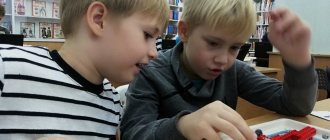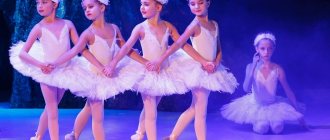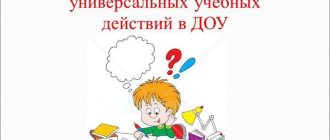Modern technologies in the education of preschool children according to the Federal State Educational Standard
Innovative technologies in education according to the Federal State Educational Standard, introduced into preschool education, are aimed at achieving state standards in this area.
The teacher conducts a lesson
Important! The position of an adult in relation to a child is especially important. He should not give orders from above or stand nearby. The adult’s position is “together” with the preschooler. The main goal of a specialist’s work is to help the child firmly stand on his feet as an individual.
On January 1, 2014, the Federal State Educational Standard (FSES) was approved, in which the child acts as a “subject” of education, being a valuable person in his own right.
Classification of educational and pedagogical technologies in preschool institutions according to the Federal State Educational Standard
Modern pedagogical technologies in preschool education in Russia are represented by various classifications, taking into account:
- Level of application (local, sectoral, general pedagogical);
- Concept of assimilation (developmental, associative-reflexive, gestalt technologies);
- Form of organization (individual training/collective, club, alternative);
- The leading type of management of cognitive activity (learning from a book/computer, classical lectures, training in small groups, tutoring);
- Approach to the child (person-oriented, humane-personal, authoritarian, free education, esoteric, cooperation technologies);
- Categories (mass, advanced education, compensatory type, work with the gifted, work with the difficult).
Important! Consideration of various methods and classifications allows us to observe a wide range of technologies that can be implemented both in preschool educational institutions and in centers of additional education.
Lesson with modern children
Innovative activities in preschool educational institutions under the conditions of the Federal State Educational Standard
The goal of innovation in working with teaching staff is to ensure the active participation of preschool teachers in methodological work, which, in turn, contributes to improving the system of continuous education and self-education of preschool teachers through the forms of innovative methodological work:
Seminars - workshops
— creative classes are aimed at developing creative thinking and creating innovative projects.
Seminar
– press conferences help to quickly find information on individual problems, deeply comprehend it, and discuss individual issues with colleagues.
Game simulation
.
Business and role-playing games involve modeling a real process, during which optimal professional decisions are made based on the analysis of artificially created pedagogical situations. A business game as a teaching method allows you to “live”
a particular practical situation.
Problem situations;
Group discussion or brainstorming
;
Trainings
in small groups to improve professional skills; methods of self-educational work, scientific and practical conferences on the results of innovative activities of preschool educational institutions.
A new form that makes it possible to comprehensively solve basic practical and research problems, to integrate various educational forms of training for teachers in an innovative institution, is a scientific and methodological council .
The work of the scientific and methodological council includes a creative group of teachers, the head of the preschool educational institution and a senior teacher. Like-minded people of the scientific and methodological council are developing a strategy, constructive and methodological schemes for implementing the general concept, a model of the institution and its main structures, methods for studying the cultural, educational and professional needs of all participants in the pedagogical process. An important place in the content of the work of the scientific and methodological council is occupied by the analysis of the activities of the institution, the results of the use of new pedagogical technologies, analysis of the professional activities of team members, consideration of prognostic programs and projects, analysis and approval of didactic and methodological materials, generalization of experience.
Thus, the use of these and other active forms and methods of teaching in the process of improving the professional skills of preschool teachers ensures the practice-oriented nature of the educational process, promotes inclusion in innovative activities, and the formation of the need for continuous professional improvement.
The level of methodological training of the teacher and his ability to improve professionally were studied using testing and questioning methods. Based on testing
we can conclude: educators experience difficulties in drawing up partial programs, mastering ICT technologies, organizing role-playing games, establishing person-oriented interaction, and often cannot solve problems that arise when working with parents.
Innovative technologies in preschool education
Modern innovative technologies according to the Federal State Educational Standard in preschool education have been considered by many authors: N. D. Malakhova, A. M. Moiseeva, V. S. Lazarev. Pedagogical innovation is defined as the introduction of innovations into the state educational environment that improve the system as a whole. In the process of introducing innovations, there is a creative rethinking of programs and methods - this is the main feature of the technology.
How does innovation occur in early childhood education?
- In a series of scientific research.
- Due to the need for innovation in preschools and primary schools.
- They arise as a result of the variable creativity of teachers.
- They arise due to the great desire of parents to reveal the potential of the baby and observe the positive dynamics of development.
Important! Innovative teaching methods carried out in preschool educational institutions according to the Federal State Educational Standard are not completely new and universal technologies for teachers. These are just effective ways to use traditional parenting methods, improved and supplemented by modern research.
Pedagogical technologies of preschool education of our time
Technology is a set of techniques that are used in a particular art or business.
The use of modern educational and pedagogical technologies in kindergarten must meet such technology criteria as:
- Conceptuality (a certain scientific concept is taken, which includes the rationale for achieving educational goals);
- Systematicity (logic, list of interrelations of all parts of the system, integrity);
- Manageability (goal setting, design of a learning model, correction of results, step-by-step diagnostics, drawing up plans and reports);
- Efficiency (considers the optimality of costs and the guarantee of achieving set goals);
- Reproducibility (implies the specifics of pedagogical technology and its possible reproduction in a new place).
Form of health-saving technologies in physical education
The list of modern educational technologies includes:
- Innovative technologies in the field of health and physical education - all technologies related to the impact on the health of a preschooler at any level (psychological, energetic or informational). The goal is to preserve the baby’s health and develop all the necessary skills and abilities to maintain a healthy lifestyle.
- Interactive. Due to the fact that children are “thrown” into the sphere for interpersonal interaction, their social and personal experience is enriched. This could be conversations, observations, or conducting small experiments.
- Information and communication. In this technology, education should include new elements - an interactive board (on which the teacher can show presentations, thematic films and cartoons), a computer or tablet.
- Personality-oriented. In this case, the personality of the preschooler is placed at the center of systemic education, regardless of his age. It is necessary to provide the baby with comfortable conditions for safe and conflict-free development and the full realization of his natural potential.
- Gaming technologies are built as a comprehensive education, capturing a small part of the educational process and united by a common plot. An example would be games aimed at developing the ability to identify features of objects and compare them with each other.
Children's finger gymnastics for kindergarten
Interactive education technologies
Interactive education, translated from English into Russian, means the organization of cognitive activity in the mode of active interaction - dialogue or conversation.
Important! The teacher of a preschool institution, secondary education or university ceases to be a “center” for students. He regulates the communication process, organizes it, formulates brief topics or questions for discussion, advises and monitors the order of exercises.
The following can be used as interactive technologies in preschool institutions:
- Exercise “Microphone”, where children, together with the teacher, pass a toy microphone to each other in a circle and speak on a topic given by the adults. This may be the first task in teaching culture - to talk about yourself, about your mood at the moment.
- Impromptu debates. Children also stand in a circle and speak out on a given topic. However, the words of each preschooler can be discussed. For example, Misha said that he was in a bad mood while listening to music. Children take turns raising their hands and saying how Misha can improve his mood.
- Synthesis of thoughts. During this exercise, children unite in small groups to complete a joint task. For example, they help a math bunny count all the apples on a sheet and color them.
In kindergartens that have passed state certification, 3 main forms of interactive learning have long been adopted: in pairs (2 children), microgroups (up to 4 children) and small groups (up to 6 preschoolers).
Important! In such technologies, you should not say “correct” when answering a child. It is better to use words such as “good”, “original”, “interesting”. This will encourage the baby to talk further.
A preschooler sitting on a chair is not learning. He listens, but does not hear. Therefore, it is so important to always “draw” him into learning, to make sure that the baby himself becomes part of this process.
One of the forms of interactive classes
Innovative technologies for physical education of preschool children
How are innovative technologies used in children's development? Due to the combination of progressive technologies and stereotypical basic elements of education, innovations have a good effect on the personal development of a preschooler, involving him in the sociocultural environment.
The reports and abstracts highlight the main innovation in the system of physical education for preschool children - the separation of the areas “Health” and “Physical Education”.
Thus, “Health” helps to preserve and strengthen the psyche of children, develop hygiene skills and form general ideas about a healthy lifestyle.
Children's experimentation as a means of cognitive development
“Physical education” deals with the development of the physical qualities of a preschooler, mastering basic sports movements and the formation of a further need for activity.
Technologies in the field of “Health” are divided into the following:
- health-saving (preserving health in all possible ways);
- health-promoting (stimulating and promoting health - physical events and holidays, physical education sessions, etc.);
- therapeutic and recreational (health compensation occurs - massages, visits to salt rooms, infrared saunas);
- health-forming (ways to increase health - physical education and recreational activities).
Fitness technologies in preschool educational institutions according to the Federal State Educational Standard
Previously, fitness technologies were used only in foreign education methods. Recently, fitness has been considered in the complex of the field of “Physical Culture”.
Important! This is an innovative system that affects the health and improvement of the physical fitness of a preschooler.
Fitness methods and training technologies include:
- step aerobics;
- rhythmoplasty;
- dance and play gymnastics;
- stretching elements;
- fitball exercises.
Thanks to the development of fitness in Russia, many interesting trends have emerged that are also applicable in preschool education. However, most classes carried out using fitness technology can only be carried out if the child has a doctor’s certificate. Otherwise, such activities are contraindicated.
Physical education classes on fitball
Gaming technologies for additional education
In additional education, games “for the sake of learning” are widely used. In the process of activity, the child develops interests in knowledge, accumulates thematic knowledge and abilities. The pedagogical game has a clearly defined goal and contributes to the achievement of a certain result. For the most part, learning in the game is unobtrusive and voluntary. For a child, play is a much more desirable reality than existing reality.
Gaming technologies, depending on the methodology, are divided into:
- role-playing;
- plot;
- imitation;
- psychodramatic;
- business;
- organizational and activity.
It is better to explain the game in an introduction related to the topic of the lesson. You can fully explain the essence of the game as the action progresses. The teacher’s task is to organize gaming activities for all children (both actively participating and fans).
Important! The game process should be accompanied by a dialogue between the teacher and children. Moreover, even if the kids answered incorrectly (in a word game), the teacher needs to repeat their answer. This way preschoolers can better follow the progress of the action.
The problem of productive use of modern educational technologies in preschool educational institutions
Most educational technologies and methods require numerous illustrative and educational materials, the preparation of a huge amount of documentation and reports, and increasing the level of computer skills among staff (to create simple presentations).
Teachers' busy schedules have a negative impact on the introduction of innovative technologies into the education process.
Many public preschool institutions do not have computers for each teacher, nor do they have a sufficient number of teaching materials and games. Due to the high busyness of educators and other preschool teachers, they do not have time to search for and prepare good illustrative and educational material for classes. Therefore, year after year, the practice is to use the same games, without much innovation.
Computer games in kindergarten
Features of developmental technologies of a preschool institution
Developmental technologies in preschool institutions should be mobile - change and adapt to the given time. At the moment, children are more willing to study Russian fairy tales with the help of modern technologies (projectors, interesting presentations, etc.), rather than sitting in a circle and listening to the monotonous voice of the teacher. But everything requires moderation, so innovative technologies are based on traditional methods of education, improved and supplemented by modern research.
In the 21st century, a person must quickly assimilate information, adapt to the changing world and find his place in it every day, have flexibility of thinking and communication skills. To work productively with preschoolers, it is necessary to analyze and introduce modern teaching technologies into the pedagogical process.
Examples of original pedagogical technologies
Recently, the practice of using proprietary innovative programs in kindergartens has become increasingly common. The list of the most popular ones is given below.
Technology of developmental education Elkonina D. B.
The technology of developmental education in preschool educational institutions according to the Federal State Educational Standard is based on a program developed in the 1960-1970s. The program is focused on the development of modern scientific and theoretical thinking. Instead of rational-empirical thinking, which is based on practical observations, the teacher is faced with the task of basing the educational process on theoretical knowledge. They are based on meaningful generalizations. As part of the process, the method of problematizing knowledge, the methodology of educational tasks and collective mental activity are used.
Principles of developmental education
Pedagogy of cooperation Ushinsky K. D.
The pedagogy of cooperation is different:
- unity of training and education;
- humane and personal approach to the pupil;
- pedagogy of relationships.
Sequence of stages of implementation of problem-based learning technology
Additional Information! The pedagogy of cooperation implies that the student and teacher develop together, that mutual understanding is established between them. It also means that a preschool educational institution or school institution is the main factor in the education of the individual.
TRIZ technology Altshuler G. S.
TRIZ is a technology for solving inventive problems. This program implies that, knowing the laws of technical systems, you can instantly, without errors, find solutions to various problems.
If TRIZ is used in a preschool educational institution, the child learns to understand the essence of the subject, find contradictions in it, and then develops his imagination. In the long term, TRIZ develops a child in such a way that he learns to find a way out of any difficult situations using inventive thinking.
The essence of TRIZ
Problem-based learning technology by J. Dewey
Appeared in the 20-30s of the last century. The essence of the method is the creation of problem situations by the teacher, the development of activities with a focus on work and play. Students must resolve the problem situation on their own. This helps to satisfy the 4 basic instincts of learning (according to J. Dewey): research, construction, social and creative. As a result, the child masters creative and professional knowledge, and at the preschool level, develops mental activity.
Technology of project activities Kiseleva L. S.
Development of creative thinking, communication and cognitive skills through the implementation of projects. The teacher gives the students a task for independent implementation. Preschool students must prepare material and complete a specific task. Projects can be informational, creative, or research.
Important! The teacher’s task is to teach the child how to collect information, and the student’s task is to apply this knowledge in practice when implementing the project. In preschool educational institutions, project work is a joint activity of teachers, parents and students.



